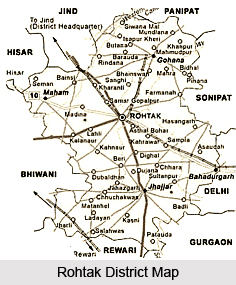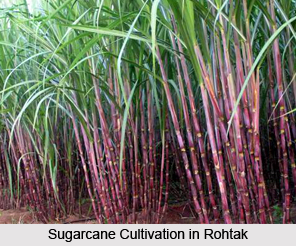 Rohtak District is one of the administrative districts of Haryana. It lies in the south east of Haryana. Rohtak is the administrative headquarters of Rohtak District. This district is bounded by Jind District and by Sonipat district in the north, by Jhajjar district on the south, Jhajjar and Sonipat district in the east and Hisar and Bhiwani districts in its west. Administration of Rohtak District is headed by a Deputy Commissioner. This district has two sub-divisions namely Rohtak and Meham. The sub-tehsil of Rohtak District is Sampla. There is no perennial river in Rohtak District. Underground water level is relatively high. The district is faces the problem of brackish water and water logging in many parts. The sub soil water depth varies from 4 to 40 feet.
Rohtak District is one of the administrative districts of Haryana. It lies in the south east of Haryana. Rohtak is the administrative headquarters of Rohtak District. This district is bounded by Jind District and by Sonipat district in the north, by Jhajjar district on the south, Jhajjar and Sonipat district in the east and Hisar and Bhiwani districts in its west. Administration of Rohtak District is headed by a Deputy Commissioner. This district has two sub-divisions namely Rohtak and Meham. The sub-tehsil of Rohtak District is Sampla. There is no perennial river in Rohtak District. Underground water level is relatively high. The district is faces the problem of brackish water and water logging in many parts. The sub soil water depth varies from 4 to 40 feet.
History of Rohtak District
Rohtak District was initially formed in the year. However, in 1841, it was abolished. After its transfer to Punjab, Rohtak District experienced several changes before assuming its present form. Bahadurgarh estate was added to the Sampla tehsil, five detached village to the east, going to Delhi. Jhajjar including some areas of Narnaul, Kanaudh and Dahari was at first created as a new district but was abolished shortly afterwards in 1860, when large parts of it were assigned to the phulkian chief as a rewards for their loyal services. While Jhajjar tehsil itself was added to Rohtak District several Badali villages were transferred either to Delhi or Gurgaon and detached Jhajjar estates were given to the Raja of Jind. In the following year,  Meham tehsil was abolished and after making necessary territorial adjustments in favour of Hisar and Delhi, the rest of the area was added to Rohtak tehsil. All these changes were completed by 1st of July, 1861. Reorganisation of Rohtak District was done in the year 1989.
Meham tehsil was abolished and after making necessary territorial adjustments in favour of Hisar and Delhi, the rest of the area was added to Rohtak tehsil. All these changes were completed by 1st of July, 1861. Reorganisation of Rohtak District was done in the year 1989.
Economy of Rohtak District
Economy of Rohtak District is primarily based on agriculture that is it has an agrarian economy. Near about 51.89 percent of the total workers are engaged in agriculture and allied activities, 7.68 percent in cottage and household industries and the rest are engaged in other activities. Out of total geographical area of the district, around 83 percent is under cultivation. The main crops cultivated here are wheat, gram, sugarcane and bajra. Modern technology has been adopted in farming. Though agriculture is the main activity in Rohtak District, it dose not provide sufficient income. To supplement their meager income, they are engaged in various allied activities like dairy, poultry, piggery, sheep, goat rearing etc. The district has one milk plant unit at Rohtak. Industrially, Rohtak is one of the fast developing districts of Haryana, having good industrial base with large and medium scale industries along with many small scale units. The distribution of industrial activities is however uneven. The majority of industrial units are concentrated at Rohtak Delhi Road.
Rohtak District`s ample agricultural resources, availability of skilled labourers, a good network of infrastructural facilities and various incentives offered by the government coupled with its close proximity to Delhi has given impetus to the new enterprises to establish several industries here. Rohtak District is well provided with other essential
services like postal services, education and healthcare facilities.






